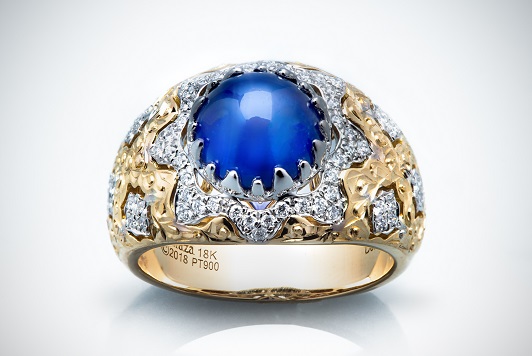
It was with a nod to his heritage that Ziad Noshie founded Almaza Jewelers in Houston, Texas, in 1968. “Almaza” means “diamond” in Arabic, and the Ghana-born Noshie is the son of a Lebanese diamond merchant. A world traveler, winery owner, and collector of museum-quality art, Noshie brings a fine eye and skilled hand to transforming diamonds and gemstones into award-winning custom designs.
In the last 50 years, he has witnessed many changes in the jewelry industry — the most significant being the internet, with its continuing repercussions for jewelers, he says. Yet he attributes his ongoing success to staying the course and providing personalized service to his local, national and international customers. His approach to design reflects his own life experiences, beginning with an early exposure to “beautiful things.”
Global inspiration
“I grew up with a love and affinity for jewelry,” says Noshie, who recalls his father sorting uncut diamonds by color and size and wrapping them in white handkerchiefs. Later, travel gave Noshie the opportunity to explore new countries and cultures. “Every three months in the 1970s, I took a trip around the world,” he explains; he still remembers the Pan Am flight numbers.
Noshie credits much of his creative inspiration to his extensive travels. He is still fascinated by African art. “Everything about it made an impact on me,” he says, citing the use of hammered gold in his designs.
After studying business at the University of Houston and jewelry-making at the Museum of Fine Arts, Houston, Noshie chose to remain in his adopted city, where he feels very much at home. And he scoffs at the stereotype that in Texas, everything has to be big. “I hate when people claim, ‘This is the biggest store’ or ‘We have the biggest inventory.’ What does that have to do with designing?”
From the ground up
Noshie’s design approach is a hands-on one. He declares that “99% of jewelers in the US do casting. I don’t; I do fabrication. Everything is done from scratch — I pull the wire through myself.” He even refines his own gold, a process so toxic that environmental regulations prohibit it in Houston (he does it on his property outside the city limits).
His original creations have caught the industry’s attention. Since 1998, his work has received 90 awards, both nationally and internationally — including first place in the Objects of Art category in the 2016 American Gem Trade Association (AGTA) Spectrum Awards. The winning piece, Hanging Panda, consisted of 18-karat rose and white gold with mother of pearl, black and white diamonds, and tsavorites.
Colored gemstones spark Noshie’s creativity. “They are my bag,” he asserts, relishing the chance to use a fine Mozambique ruby or Zambian emerald. In his travels, he has not only collected stones from dealers, but gone into the mines to source sapphires close to the Burmese border and black opals from Lightning Ridge, Australia.
Delicate balance
Of course, as a business owner, he is cognizant of the trends that influence customer tastes. “Jewelry has become more casual, and my father designs many wearable pieces,” explains Noshie’s daughter Alissa, who works in the store along with her mother, Lydia, and sister, Amy. Alissa points to the popularity of simple solitaires with an average 1-carat stone for engagement rings, paired with stackable wedding bands. Occasionally, these are made with fine sapphires and rubies, but mostly diamonds.
A frequent attendee of the VicenzaOro jewelry show in Italy, Ziad Noshie has observed that as the price of gold increases, pieces are becoming thinner and more delicate. Even engagement rings are being designed with 1.5-millimeter shanks.
The store does not carry any branded engagement rings or lab-grown diamonds. But while Alissa is adamant that Almaza will not invest in lab-grown, she also recognizes the reality of today’s market. On occasion, she has sourced moissanite or lab-created stones in response to a request from a customer, often one of millennial age. It’s a delicate balance, weighed against the risk of losing a sale.
“We don’t want that customer to get used to stepping into another store,” insists her father.
All are welcome
Almaza’s clientele is multigenerational and diverse. Since 1992, the store has been located in Rice Village, close to Rice University and the University of Texas MD Anderson Cancer Center, which attracts patients from all over the globe. “This is an optimal location that gives us access to customers from across the country and the world,” says Alissa.
Whether local or international, all clients receive a warm welcome when they enter the store, which is guarded by a statue of Buddha and surrounded by distinctive art and rugs from Noshie’s personal collection.
“I like to create intimacy with my customers,” explains Noshie, who extends his hospitality with a glass of award-winning wine from his winery in Houston.
Yet for all the accolades he has received from industry peers, it is a recent comment from a customer that resonates especially deeply with him: “People think Disney World is the happiest place on earth,” the customer told him, “but it’s Almaza.”
almazajewelers.com
Image: Handmade men’s ring in platinum and 18-karat gold with a Ceylon star sapphire and diamondsArticle from the Rapaport Magazine - March 2019. To subscribe click here.